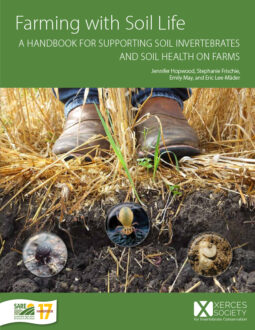SOIL MACROFAUNA includes diverse groups of animals that contribute to complex food webs as predators or decomposers. These fauna can create their own spaces in the soil and influence soil structure through the moving and mixing of soil. Macrofauna can be collected by hand and counted in the field, though identification of many species requires preserved specimens and expertise. All of the organisms in the following profiles are in Kingdom Animalia.
Woodlice (sowbugs and pillbugs)
PHYLUM: Arthropoda » SUBPHYLUM: Crustacea » CLASS: Malacostraca » ORDER: Isopoda » SUBORDER: Oniscidea
SIZE: 0.2–0.59" (5–15 mm).
ECOLOGICAL ROLE: Woodlice are primary decomposers and contribute significantly to decomposition by fragmenting fresh plant debris, which allows mites, springtails, potworms and bacteria to continue the process of forming humus. As detritivores, they can also further break down overwintered leaves and plant material that has been degraded by microorganisms.
DESCRIPTION: These terrestrial crustaceans have gray or brown bodies that are segmented and have the appearance of armor. They have powerful biting mouthparts used to fragment plant debris, seven pairs of legs and two pairs of antennae. Pillbugs (family Armadillidiidae) can roll into a ball. Sowbugs (family Porcellionidae) do not roll their bodies into a ball, and they have two noticeable short, taillike appendages called uropods on their hind end.
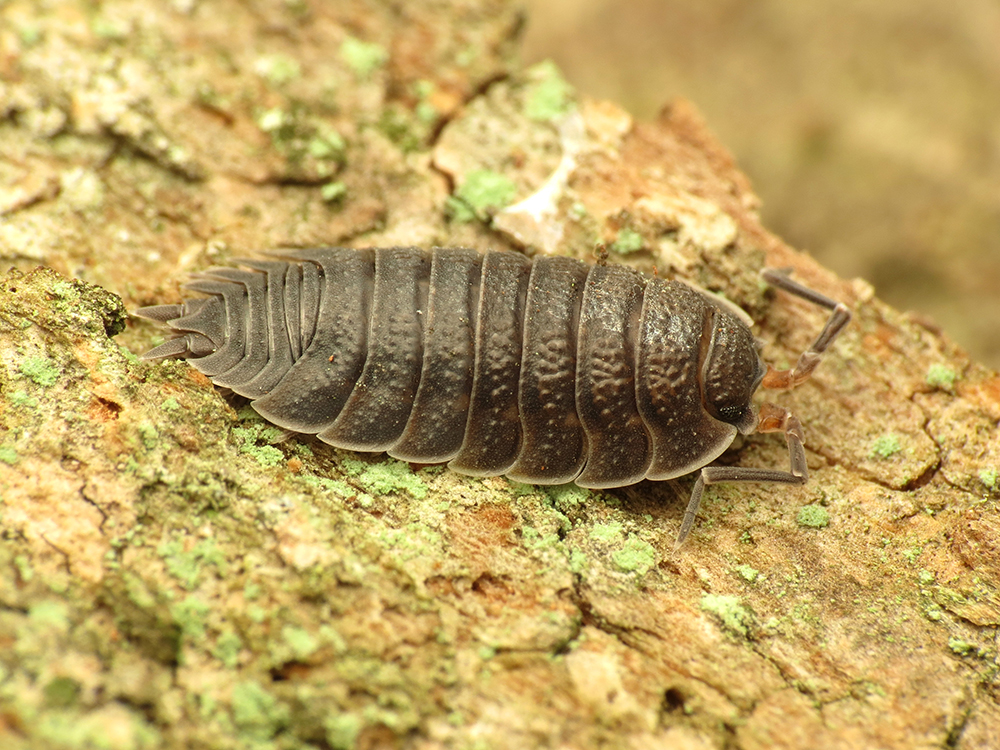
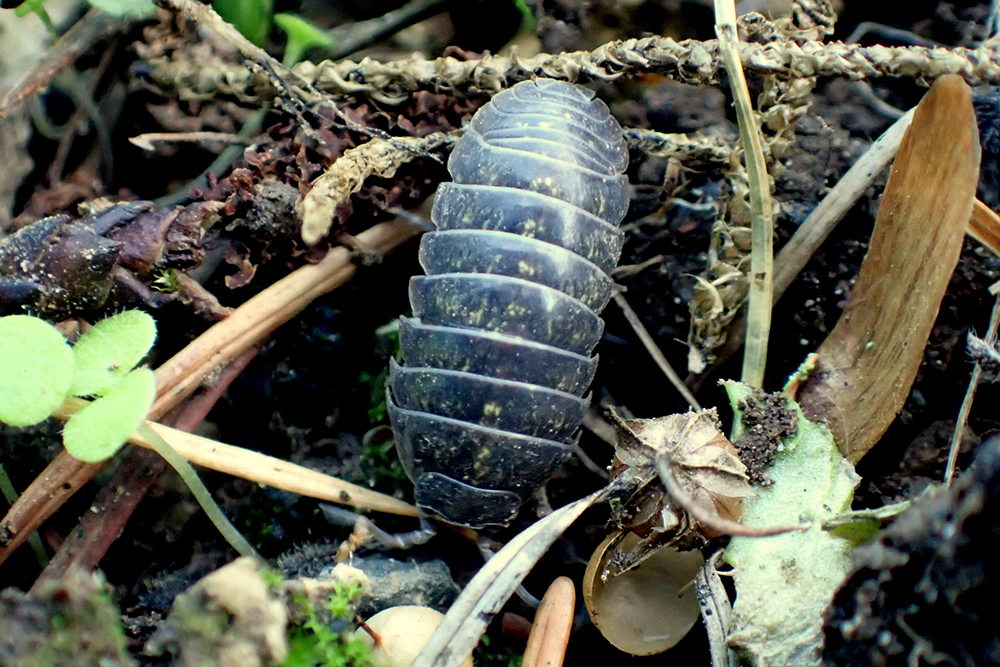
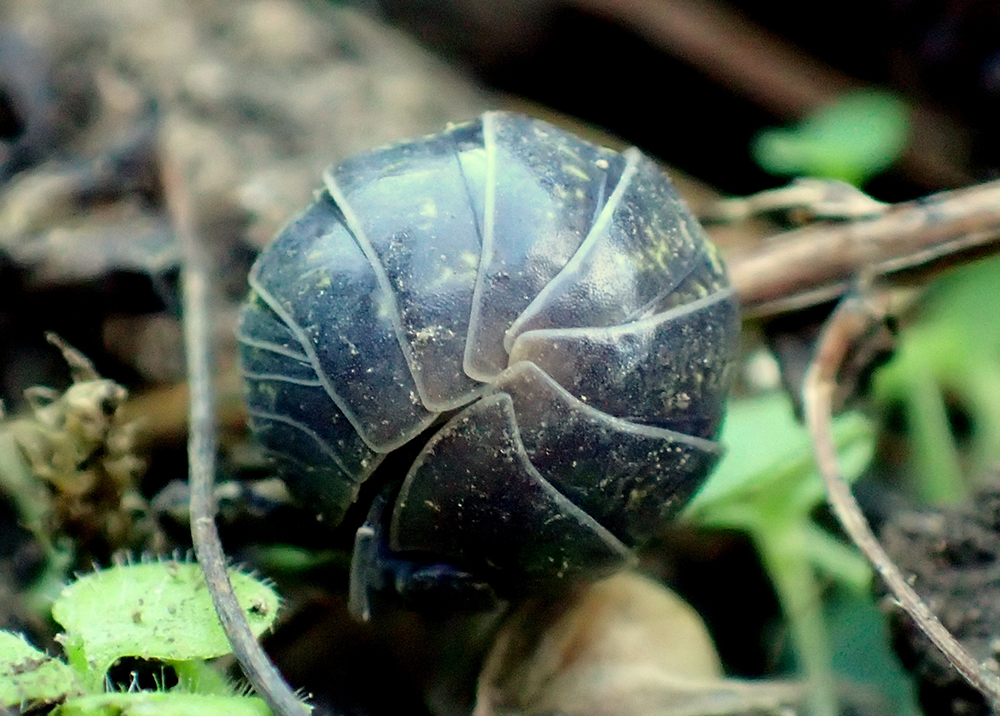
WHERE THEY ARE FOUND: Woodlice occur underneath logs, stones, and bark, and in moist leaf litter. Seasonal activity of woodlice is dependent on moisture and temperature. On cool, damp days in autumn, they are active in newly fallen leaves. In warm, dry summers, they remain in the upper soil layers and are mainly nocturnal.
WHAT THEY EAT: Woodlice are scavengers of plant material, feeding on decayed or soft matter like leaf litter. Some also feed on roots or seedlings. Many species have preferences for consuming certain leaf species.
LIFE CYCLE: Females carry eggs underneath their body, and young feed on fluid from their mother. Young molt every one to two weeks for four to five months before reaching the adult stage. Adults can live for two or more years.
APPROX. NUMBER OF KNOWN SPECIES: 3,000 worldwide (72 native to North America and 27 introduced).
RELATIVE ABUNDANCE: High in moist, temperate areas, there can be 100 to 600 per square meter.
NOTES OF INTEREST:
- Many woodlice in North America, including all pillbugs, are introduced species, originally from Europe.
- They have symbiotic bacteria in their gut that help to break down their nutrient-poor diets.
- They also eat dung from other woodlice because it contains copper, an element needed by their blood but uncommon on land. Copper is more abundant in the oceans inhabited by their marine relatives.
- Pillbugs are often known as roly-polies, due to their ability to roll into a tight ball as a defense mechanism. Woodlice have many common names: armadillobug, doodlebug, peabug, gramersow and more.
- Woodlice significantly prefer freshly fallen leaves; some species may have secondary preferences for types of foliage (e.g., holly over oak).
Crayfish
PHYLUM: Arthropoda » CLASS: Malacostraca » ORDER: Decapoda » SUPERFAMILY: Astacidea
SIZE: 1–6" (2–16 cm).
ECOLOGICAL ROLE: In soil food webs, crayfish are decomposers and predators. They are important movers and mixers of moist soil, contributing to soil turnover in poorly drained soils that are less frequented by other soil movers like earthworms.
DESCRIPTION: Like other arthropods, crayfish have a hard exoskeleton that protects their body. They have beady eyes, two pairs of antennae, four pairs of walking legs, and one pair of legs with pincers used for feeding, defense, burrowing and mating. Crayfish have a jointed abdomen and a fan-shaped tail. Many crayfish are brown or green, but some are red, blue, black or white.
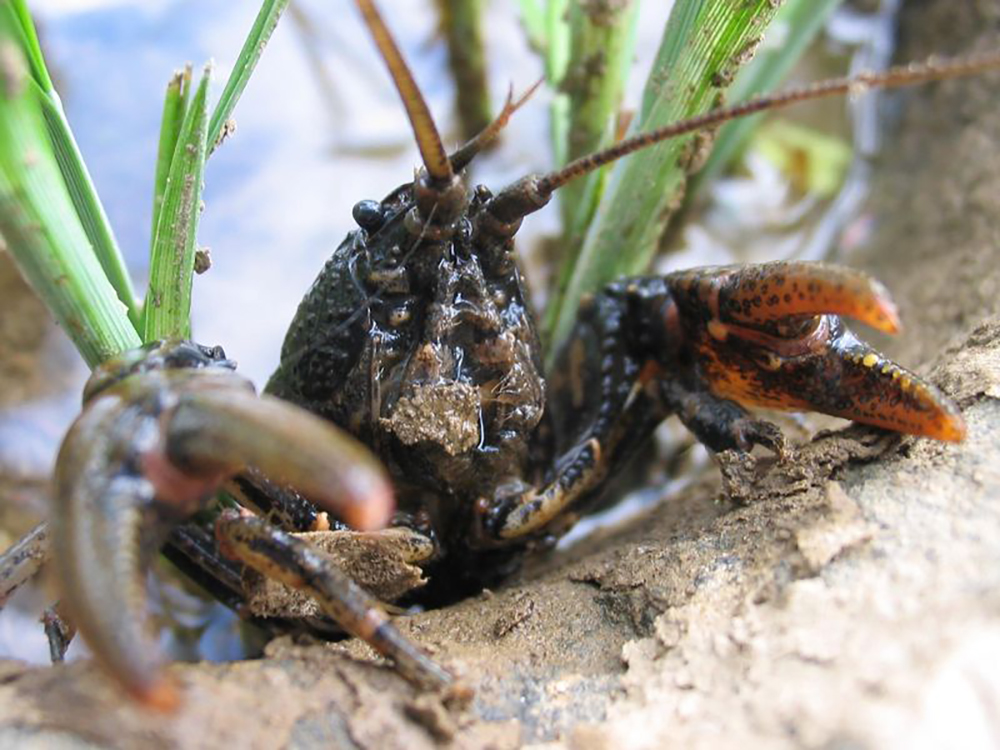
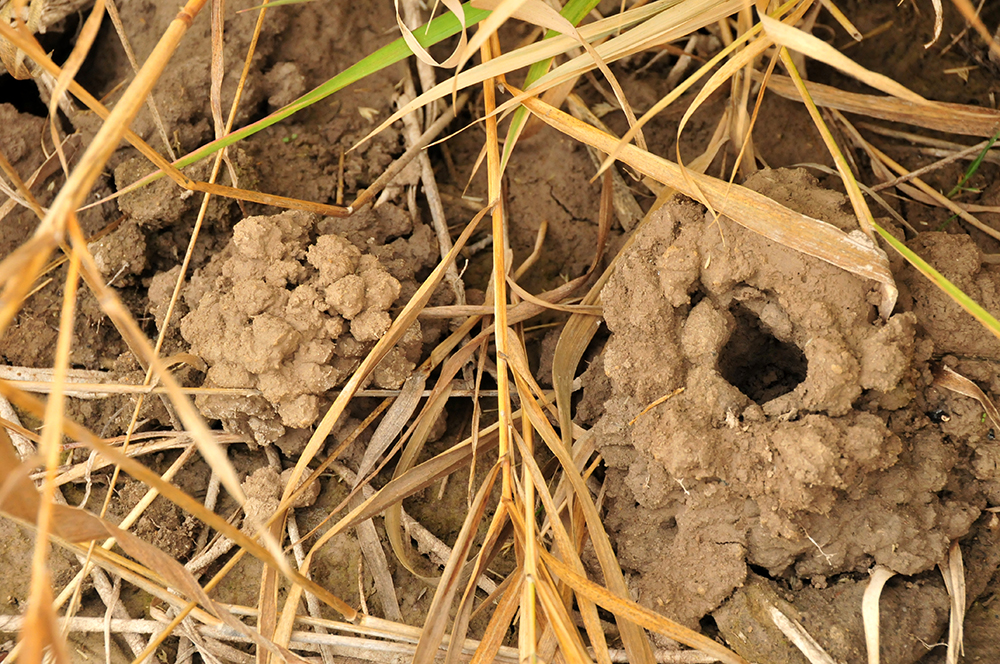
WHERE THEY ARE FOUND: Crayfish are found in burrows in moist soils, such as those in low-lying fields or forests. Crayfish burrows are as deep as the water table—the level at which soils are fully saturated—which can be up to 16.4” (5 m) deep. On the soil surface, chimneys made from excavated earth are a sign of crayfish burrowing activity; they are rarely seen above ground during the day. They also live in freshwater streams, ponds, marshes and lakes.
WHAT THEY EAT: Crayfish eat living and dead plants; prey upon insects, snails, tadpoles and fish; and also consume dead animal matter. Most crayfish feed at night.
LIFE CYCLE: Crayfish often mate in autumn, and female crayfish lay fertilized eggs in the spring, gluing them to the underside of her abdomen to incubate. After hatching, young crayfish remain near their mother for several months. Some species reach maturity within a year and others in two, and typical life spans are between two and four years.
APPROX. NUMBER OF KNOWN SPECIES: 500 worldwide (405 in North America).
RELATIVE ABUNDANCE: Crayfish are typically not abundant but can become so in years with excessive rain or in areas where the water table is raised artificially, such as rice fields.
NOTES OF INTEREST:
- Crayfish can bring more than one ton of soil to the surface per acre of land per year.
- Crayfish are critical food sources for mammals, birds and fish. Crayfish are trapped and are eaten by people as well.
- They are important in aquatic food chains, contributing to decomposition of plants and animals.
- Because they are sensitive to pesticides and heavy metals, crayfish are indicators of water quality.
- There are four species listed under the Endangered Species Act and nearly 50 species protected at the state level. Some researchers estimate that about 48% of crayfish species are imperiled. A number of species have a limited geographic range, which can make them more vulnerable.
- Nonnative crayfish are a threat to aquatic biodiversity, contributing to the decline of native crayfish and negatively impacting native fish and aquatic plants.
- There is considerable regional variation in names for this freshwater arthropod. Common names in the United States also include crawfish, crawdads and mudbugs.
Millipedes
PHYLUM: Arthropoda » SUBPHYLUM: Myriapoda » CLASS: Diplopoda
SIZE: 0.079–11" (2–280 mm) but most are 2–2.4" (5–6 cm).
ECOLOGICAL ROLE: Millipedes are primary decomposers and scavengers, and they make significant contributions to the decomposition of plant debris. Millipedes fragment 10–15% of annual leaf fall and facilitate further microbial decomposition.
DESCRIPTION: Millipedes have an elongated, segmented body with many legs—up to 375 pairs. Each body segment has two pairs of legs. They have one pair of antennae and lack structures to bite people, but they do have mandibles for chewing organic matter. Millipedes are often black, brown or gray, and sometimes with bright, colorful legs or patterns.
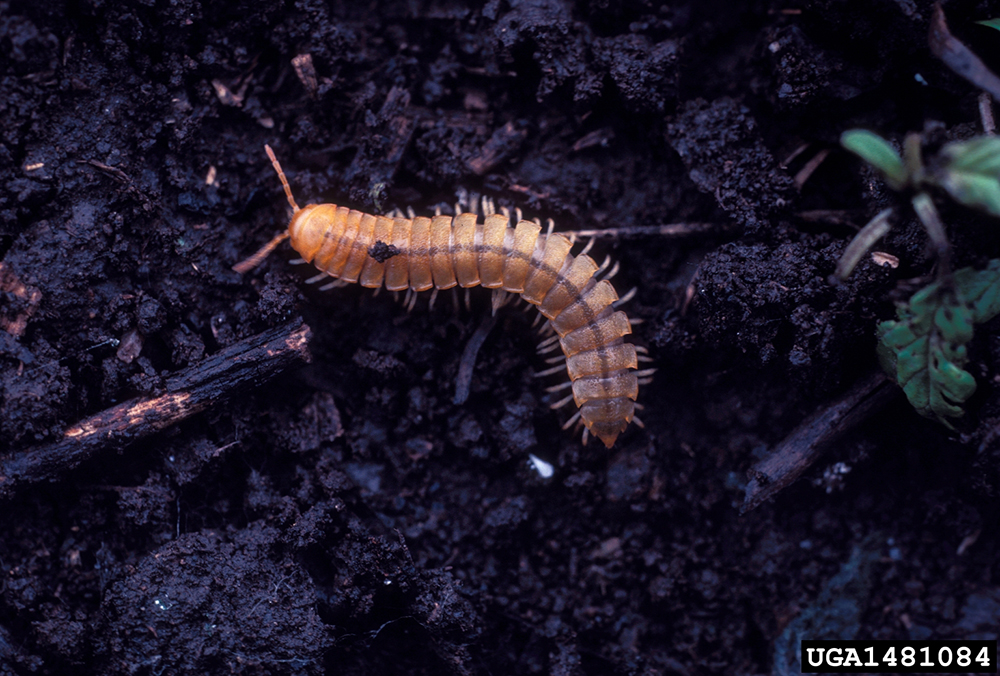
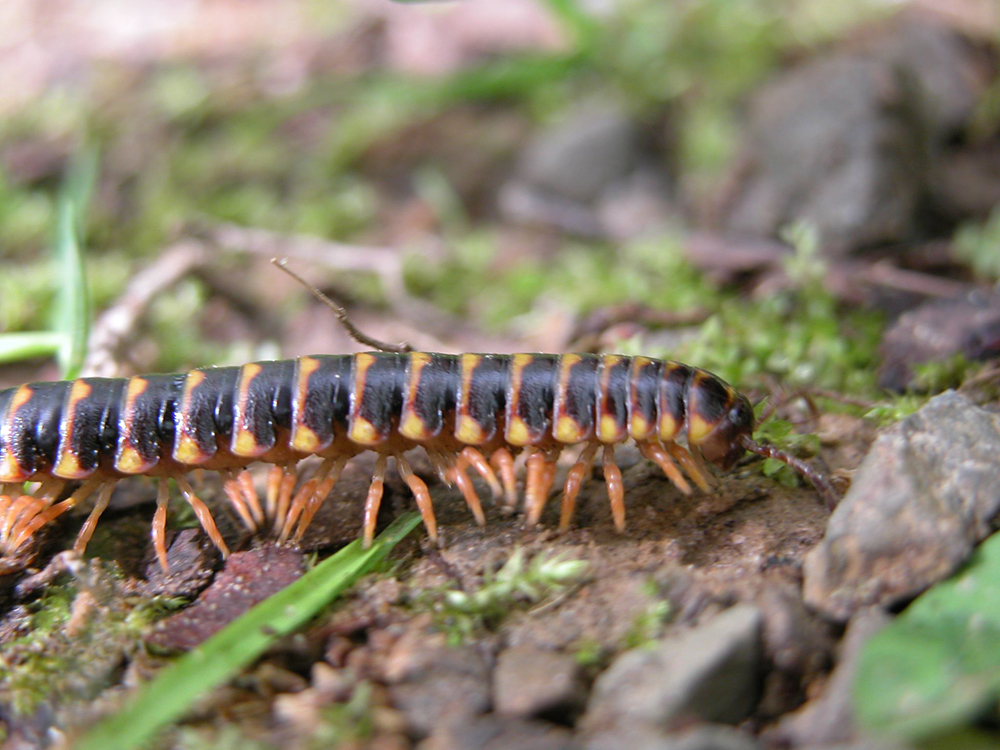
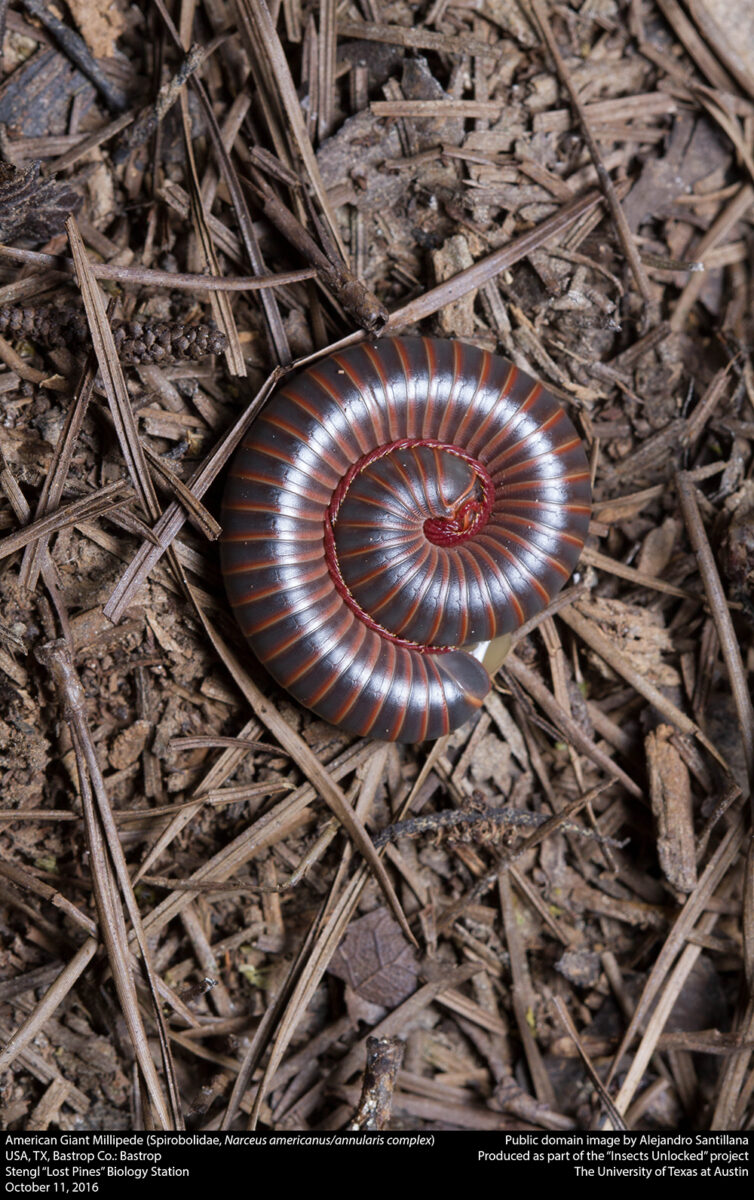
WHERETHEY ARE FOUND: Millipedes occur in all subarctic environments except deserts, but they primarily occur in moist habitats. They live under bark, logs and stones, and in leaf litter and upper soil layers. Some can excavate deep tunnels and are found in deep soil layers. Millipedes are not fast runners but are powerful diggers.
WHAT THEY EAT: Millipedes eat debris—decaying vegetation like fallen leaves, algae and fungi. They are selective feeders, preferring leaf litter with high calcium and avoiding freshly fallen leaves.
LIFE CYCLE: Millipedes have a life span up to 11 years. A female millipede covers her eggs in a ball made of soil particles and droppings and places them in a nest, which she guards. When millipedes molt, they create their own nests for shelter during the process.
APPROX. NUMBER OF KNOWN SPECIES:12,000 worldwide (915 in North America).
RELATIVE ABUNDANCE: In temperate regions, there can be 10 to more than 100 individuals per square meter, but millipedes can be especially abundant in temperate forests, with numbers up to 1,000 per square meter.
NOTES OF INTEREST:
- Millipedes in the genus Motyxia are bioluminescent, helping to warn off potential predators.
- One defense mechanism is to roll into a ball or a coil. Pill millipedes, in the superorder Oniscomorpha, take this to a whole other level, enclosing their head, legs, and more.
- Defensive secretions either smell terrible or contain toxic substances.
- Their droppings contribute to humus and soil formation.
- When the soil is too hard, millipedes in the family Iulidae (alternative spelling of Julidae) eat their way through.
- Millipede means “thousand feet” but none are known to actually have 1,000 legs (the maximum is 750, in Illacme plenipes, which is also the animal with the most legs).
- The largest millipede in the world, Archispirostreptus gigas, known as the giant African millipede, is more than 15" (38.1 cm) long and can live up to seven years.
Centipedes
PHYLUM: Arthropoda » SUBPHYLUM: Myriapoda » CLASS: Chilopoda
SIZE: 0.12–11.8" (3–300 mm).
ECOLOGICAL ROLE: In soil food webs, centipedes are predators. Some are also detritivores.
DESCRIPTION: Centipedes have elongated, flattened, segmented bodies with one pair of legs per body segment. They have long antennae, and their first pair of walking legs are modified to inject prey with venom.
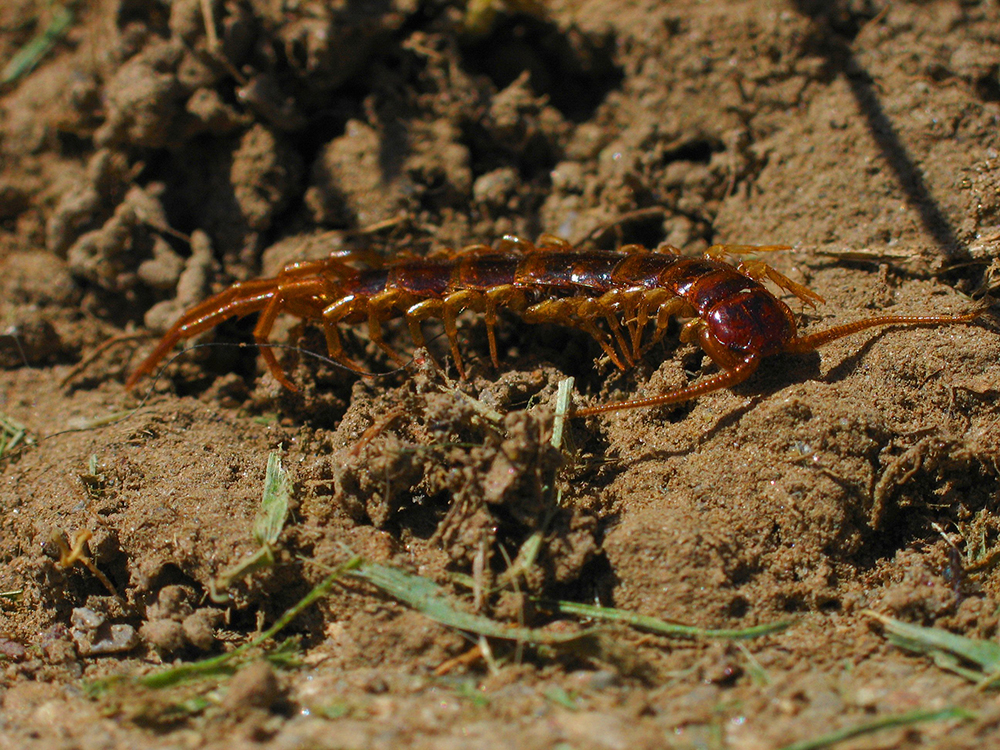
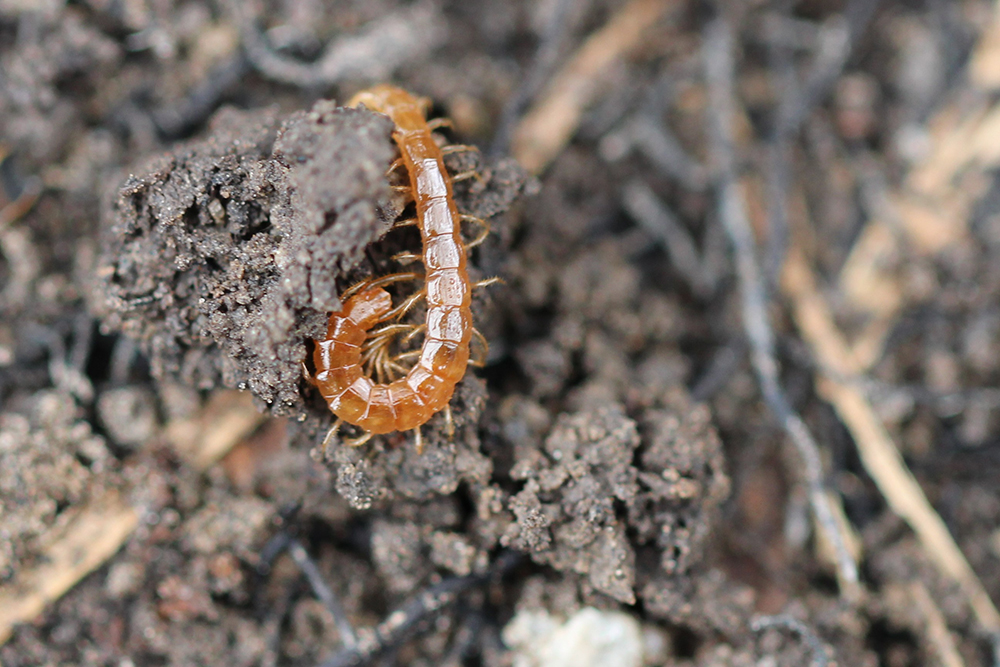
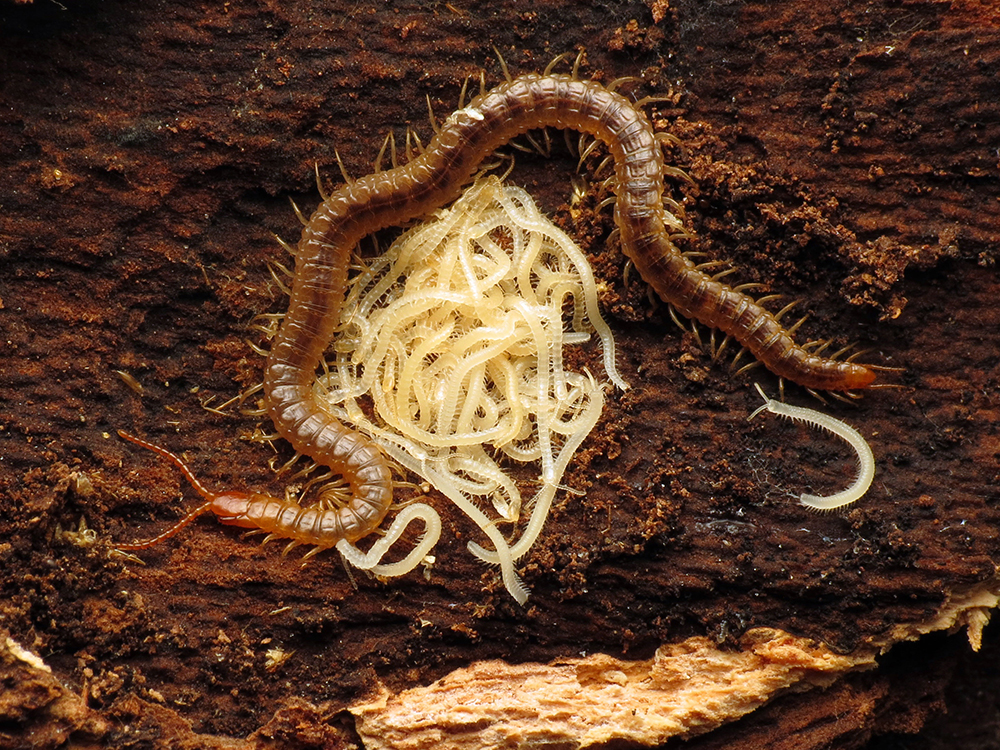
WHERE THEY ARE FOUND: Some species are adapted to live in shallow or deep soil layers, while others live under bark, logs and stones, or within leaf litter. Most species are nocturnal and more often seen at night.
WHAT THEY EAT: Centipedes eat earthworms and other arthropods, large and small (they are fast runners and will chase prey). Larger species may also prey on small mammals or reptiles. Centipedes immobilize prey by injecting it with poison, and will then tear open prey, cover it in digestive fluids, and suck out the contents. Some species will also eat plant debris on occasion.
LIFE CYCLE: Males have mating displays. Some species lay single eggs in soil, while females of other species provide parental care for a nest of eggs in soil or rotten wood. Young of some species start out with a few body segments and pairs of legs and add the rest as they grow and molt, while the young of others start out with the number of legs and segments they’ll have as adults and grow in size through molting. It can take several years for centipedes to reach adulthood, and they are relatively long-lived, with lives up to six years.
APPROX. NUMBER OF KNOWN SPECIES: 3,000 worldwide (40 in North America).
RELATIVE ABUNDANCE: Data unavailable.
NOTES OF INTEREST:
- Female centipedes guard eggs, licking them to reduce fungal infections.
- Many centipedes are fast runners, and larger species can bite people if handled.
- The largest species, Scolopendra gigantea, occurring in South America, is among the world’s largest terrestrial invertebrates and largest invertebrate carnivores.
Spiders
PHYLUM: Arthropoda » CLASS: Arachnida » ORDER: Araneae » FAMILIES: Agelenidae, Atypidae, Clubionidae, Gnaphosidae, Hahniidae, Lycosidae, Salticidae
SIZE: 0.079–1.18" (2–30 mm).
ECOLOGICAL ROLE: As predators that either hunt down prey or spin complex webs to trap prey, spiders help regulate arthropod populations. As diggers, they also move and work the soil.
DESCRIPTION: Spiders have four pairs of walking legs and two body regions, known as the cephalothorax (the head and thorax combined) and the abdomen. Silk-spinning organs are found at the posterior end of the abdomen. Most spiders have eight eyes, the arrangement of which can help identify spider groups. The spiders use their jaws, called chelicerae, to hold prey and inject poison or to help burrow into soil.
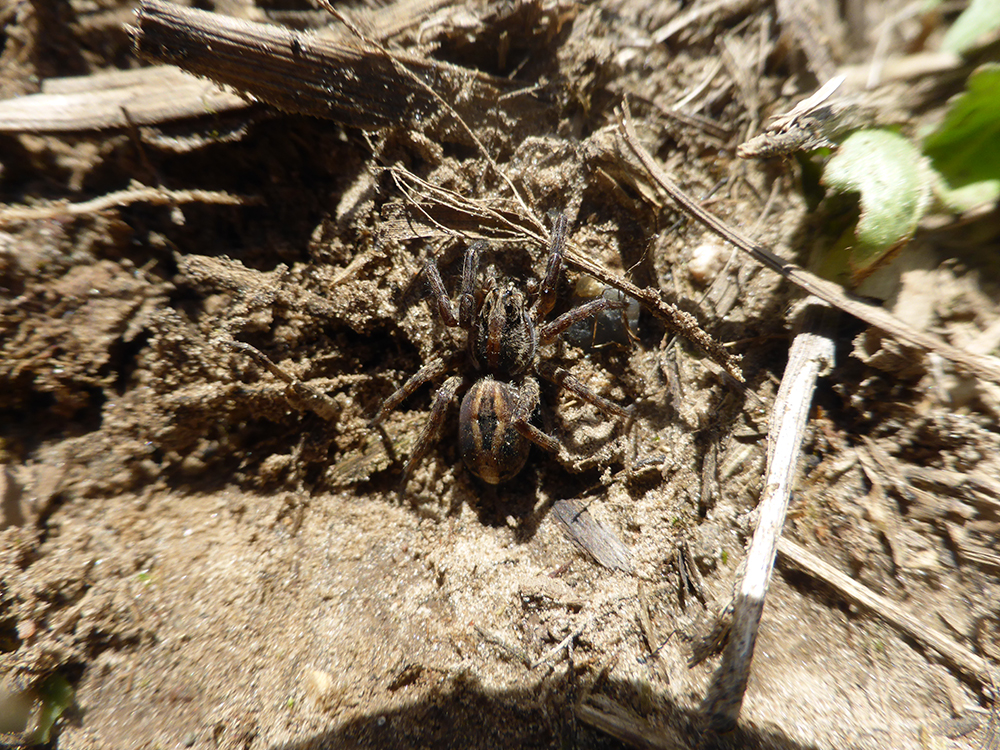
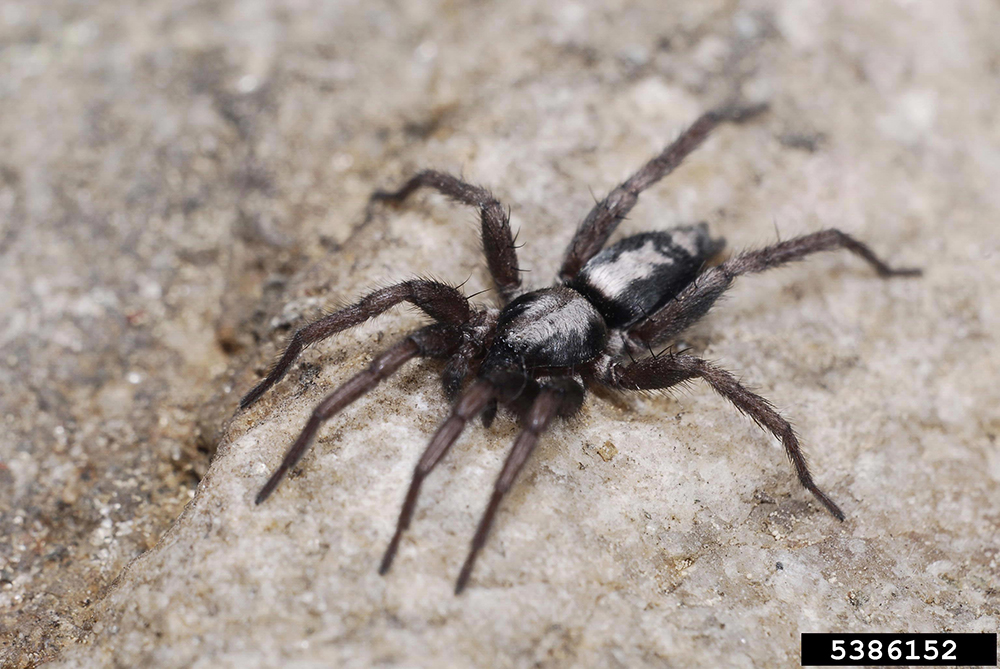
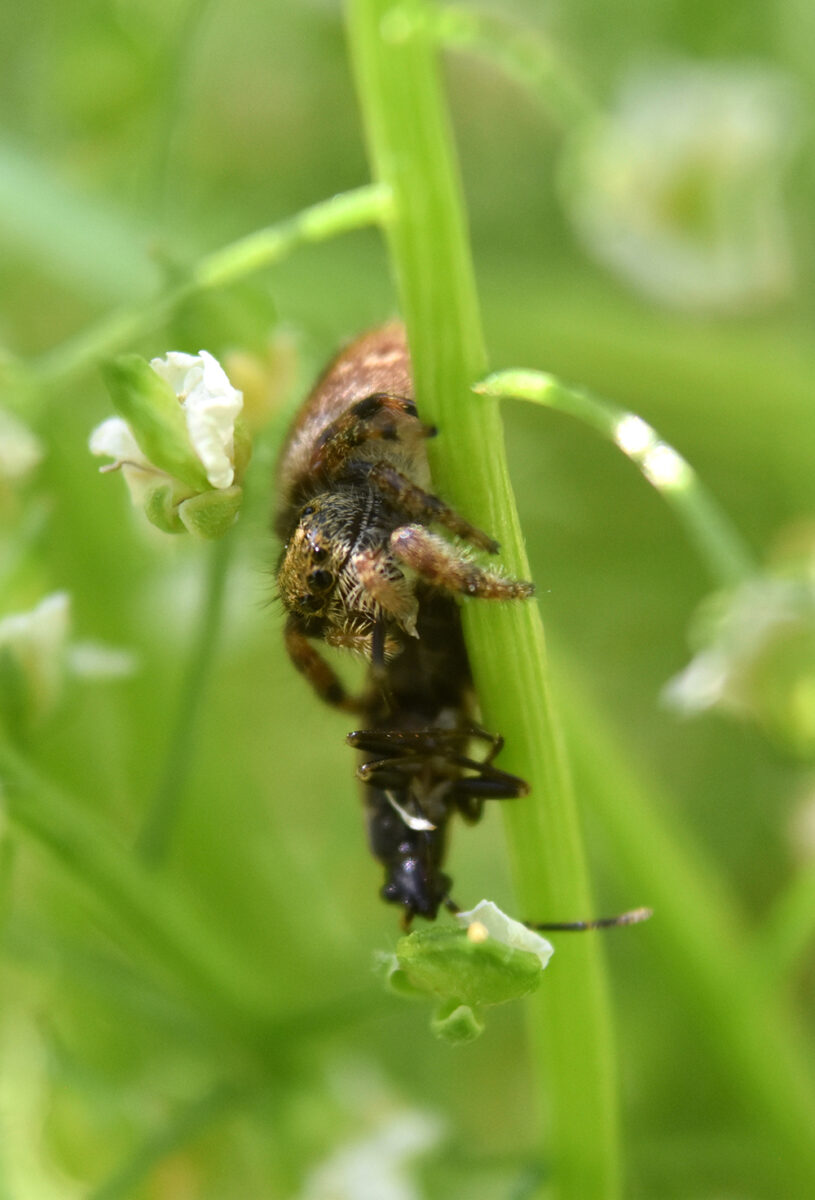
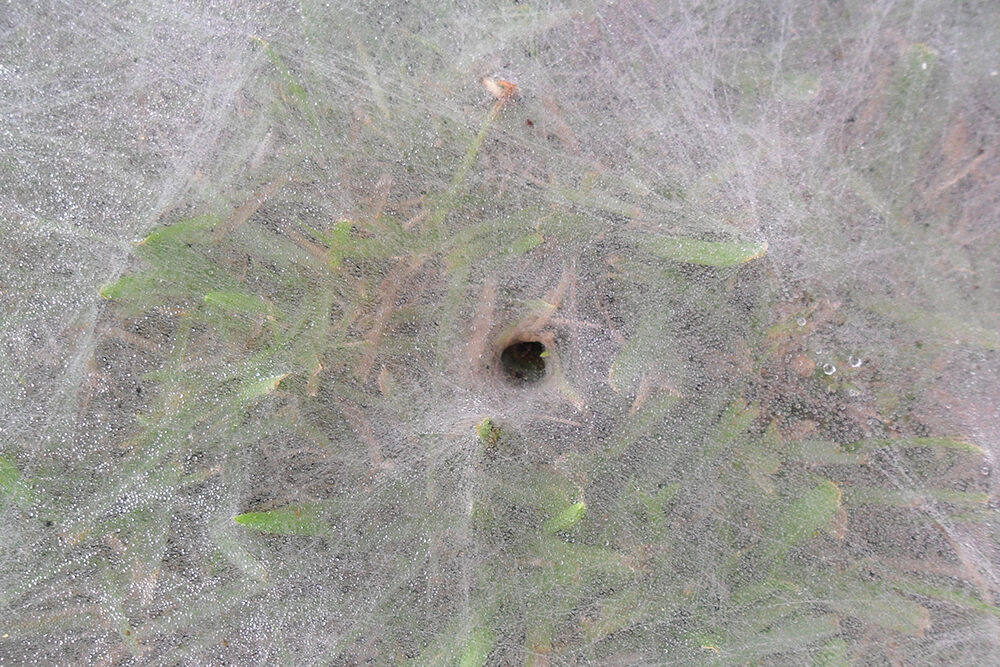
HUNTING SPIDERS THAT ARE SEEN MOST OFTEN: Wolf spiders (Lycosidae) have brown, black or dirty-yellow coloration, often with one or more longitudinal stripes on their backs. Jumping spiders (Salticidae) have variable body coloration, usually dark with iridescent patterns, a fuzzy appearance and large, forward-facing eyes. Ground spiders (Gnaphosidae) are dark and drab with prominent spinnerets.
WHERE THEY ARE FOUND: Web-building spiders, such as dwarf sheet spiders (Hahniidae), sac spiders (Clubionidae) or funnel weavers (Agelenidae), are found within webs spun in or directly on the ground. These webs may be domes, funnels, tubes or simple sheets across the surface. For example, purseweb spiders (Atypidae) construct deep, vertical tubes of silk and wait to ambush insects from below, pulling them into the tunnel. Hunting spiders, such as wolf spiders, ground spiders or jumping spiders, are all found on the soil surface or in leaf litter.
WHAT THEY EAT: Spiders eat other arthropods, including many insects.
LIFE CYCLE: Spiders may lay eggs within silken sacs in leaf litter, attached to their web or attached to their body. Adults or eggs overwinter in silken nests in soil, grass clumps, and leaf litter; under bark; or inside hollow stalks of vegetation. Most spiders have one generation a year. Adults can live for one to three years.
APPROX. NUMBER OF KNOWN SPECIES: 2,430 wolf spiders worldwide (240 in North America), 6,175 jumping spiders worldwide (315 in North America), 1,330 funnel weavers worldwide (116 in North America), 54 purseweb spiders worldwide (eight in North America), 630 sac spiders worldwide (58 in North America), 350 dwarf sheet spiders worldwide (58 in North America) and 2,520 ground spiders worldwide (180 in North America).
RELATIVE ABUNDANCE: Spiders can be fairly abundant. In woodland soil, spider populations were estimated at 50 to 150 per square meter; similarly, 142 spiders per square meter were found in an English pasture.
NOTES OF INTEREST:
- Spiders have fangs on the tips of their chelicerae, and the venom within contains toxins and enzymes used to stun or kill prey and also helps to speed up digestion of prey body tissues.
- Spiders provide maternal care for their young. Wolf spiders carry their young (up to 100) on their back, and funnel weavers stay in their mother’s web for weeks. Some mothers provide regurgitated food as well.
- Sheetweb spiders (Linyphiidae) tend to catch more flying insects, and their contribution to soil health is mainly the byproducts of their meals.
- Jumping spiders always attach a safety thread before leaping.
- A group of wafer-lid trapdoor spiders (Euctenizidae) is found in the southern United States.
- Spiders are fairly territorial and have complicated mating rituals.
- Spider populations can be disrupted by planting and harvesting of crops, but they can recolonize fields if suitable habitats such as natural areas or permanently planted field borders are nearby. Greater numbers of spiders are found in no-till or reduced tillage systems.
- Pitfall traps capture spiders, and Berlese funnels are also useful for sampling.
Harvestmen
PHYLUM: Arthropoda » CLASS: Arachnida » ORDER: Opiliones » SUPERFAMILY: Phalangioidea
SIZE: 0.079–0.47" (2–12 mm).
ECOLOGICAL ROLE: Harvestmen are predators on the soil surface and also can fill the roles of decomposers, scavengers, and herbivores.
DESCRIPTION: Harvestmen have two body regions that are broadly joined and appear as one round body. Their oval bodies may have gray, brown or tan color patterns. They have eight exceptionally long, stilt-like legs, using the second pair of legs to search for prey and sense their environment. These arachnids have chelicerae but do not have venom glands, do not have silk glands and have only two eyes.
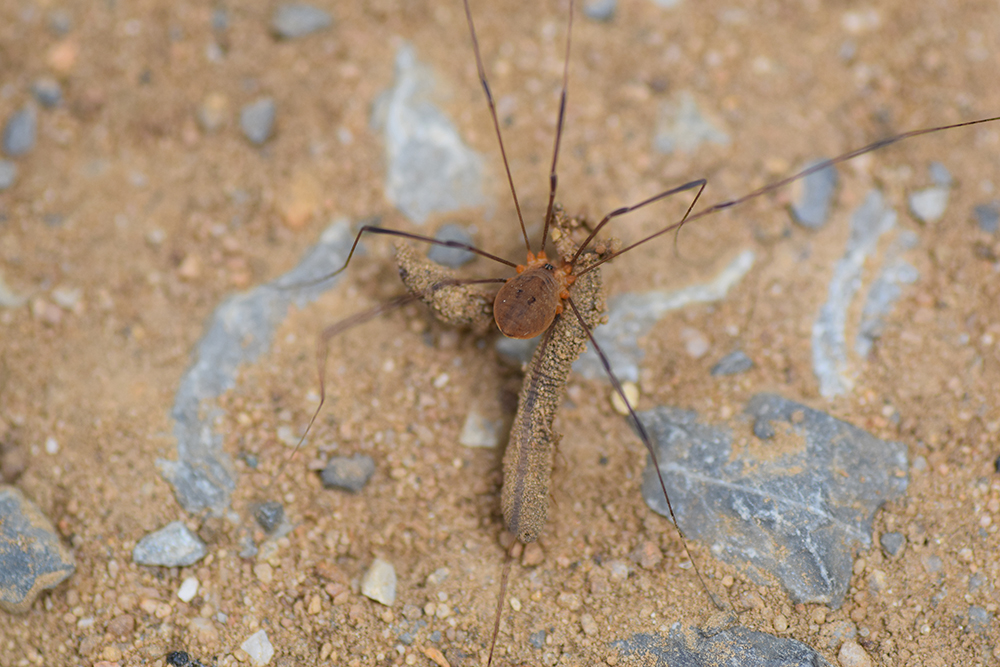
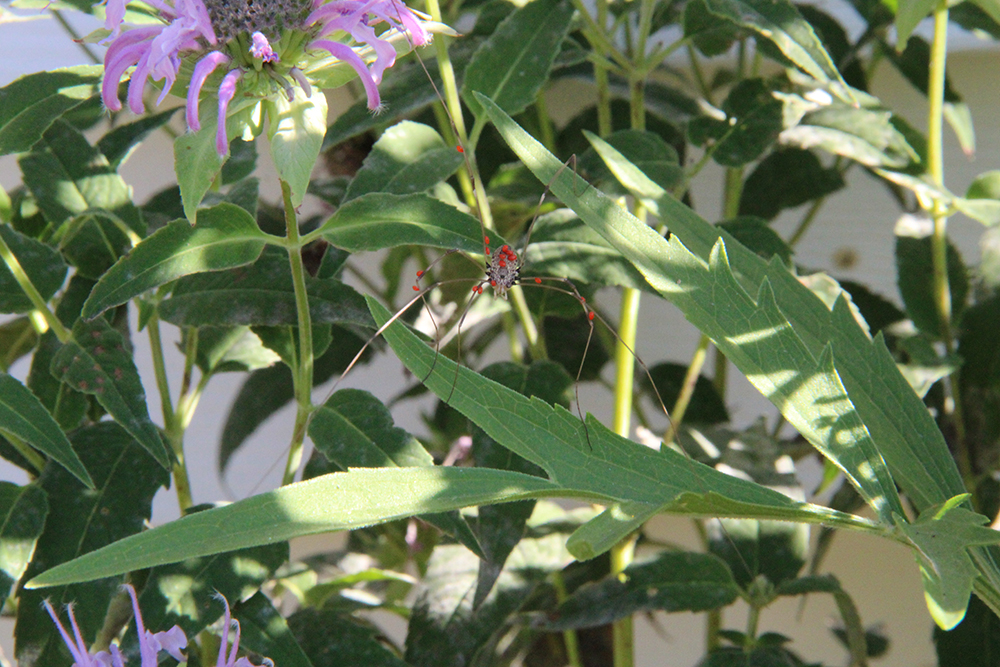
WHERE THEY ARE FOUND: Harvestmen can be found on the soil surface or in leaf litter in gardens, field edges, grasslands and woodlands.
WHAT THEY EAT: Harvestmen feed on a variety of arthropods and snails, and they are active during the day as well as during dawn and dusk. Some are omnivorous and will feed on dead plant or animal material.
LIFE CYCLE: Eggs overwinter after they are laid in soil or leaf litter in late summer and autumn. Juveniles reach maturity in the late spring or summer, depending on climate. Harvestmen lay one generation per year, and most species only live for a year.
APPROX. NUMBER OF KNOWN SPECIES:6,600 worldwide (150 in North America).
RELATIVE ABUNDANCE: Data unavailable.
NOTES OF INTEREST:
- Harvestmen are also known as daddy longlegs.
- A common urban legend suggests that harvestmen have potent venom but mouthparts too small to bite humans. In fact, they are not venomous, and their chelicerae are more suited for grasping than biting.
- Harvestmen use their second pair of legs to detect odors of food or mates, and they will preen these legs to keep them clean.
- These arachnids have stink glands and will secrete a foul substance to deter predators. Harvestmen will also break off pieces of legs if an enemy seizes it (the leg cannot be regenerated).
- Harvestmen are often a vehicle for pseudoscorpions or mites that hitch a ride to disperse further.
- Tillage can harm harvestmen populations.
Pseudoscorpions
PHYLUM: Arthropoda » CLASS: Arachnida » ORDER: Pseudoscorpiones
SIZE: 0.079–0.28" (2–7 mm).
ECOLOGICAL ROLE: Pseudoscorpions are predators, regulating populations of mesofauna of the soil.
DESCRIPTION: Pseudoscorpions have conspicuous, large appendages called pedipalps, which end in strong pincers used to capture prey or for defense. In this way, they resemble scorpions, but they do not have a tail with a stinger at the end. They have two main body regions: the cephalothorax includes the head and appendages (chelicerae, pedipalps and four pairs of walking legs), and the abdomen has 11 to 12 segments without any appendages. Some have simple eyes, while others are blind.
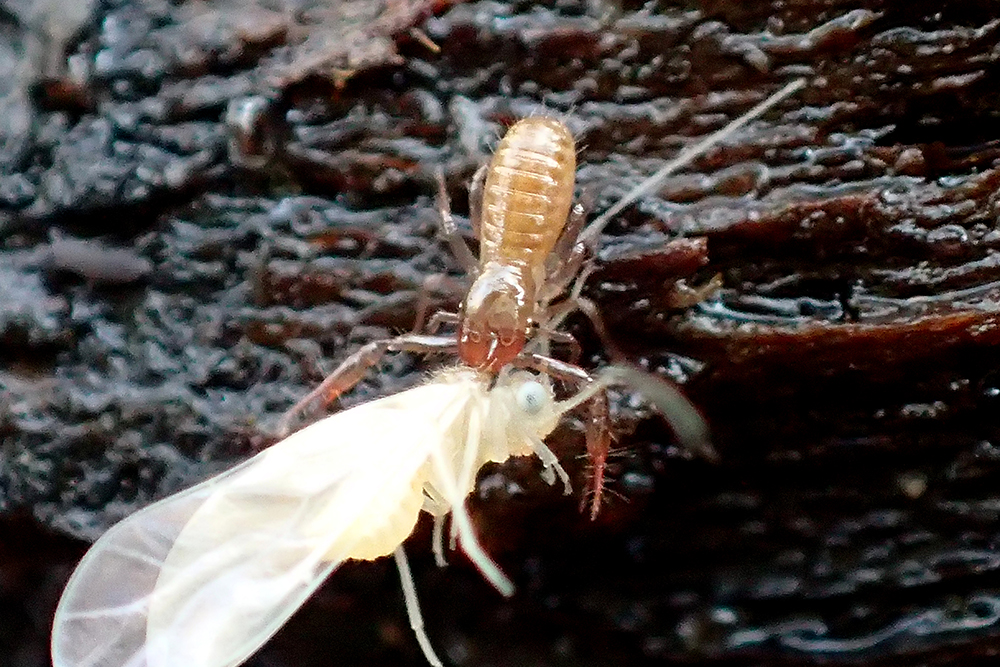
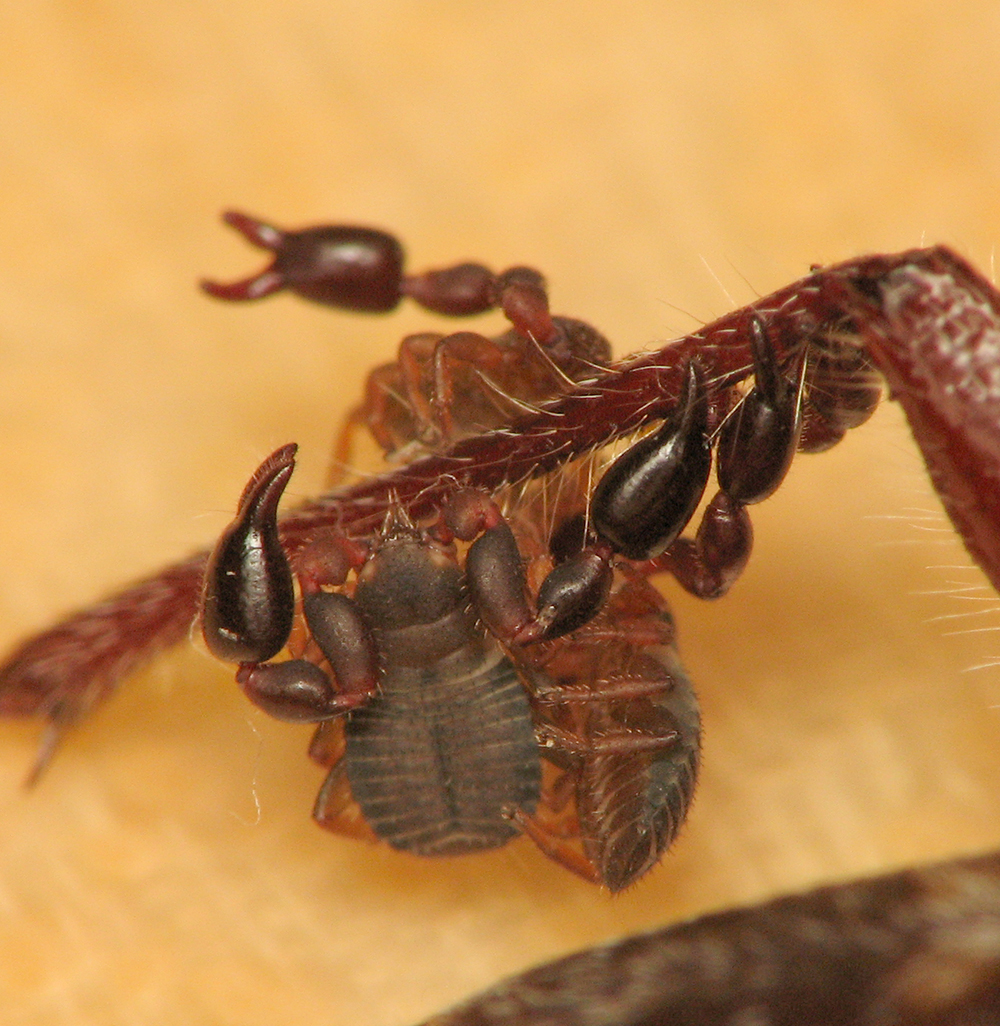
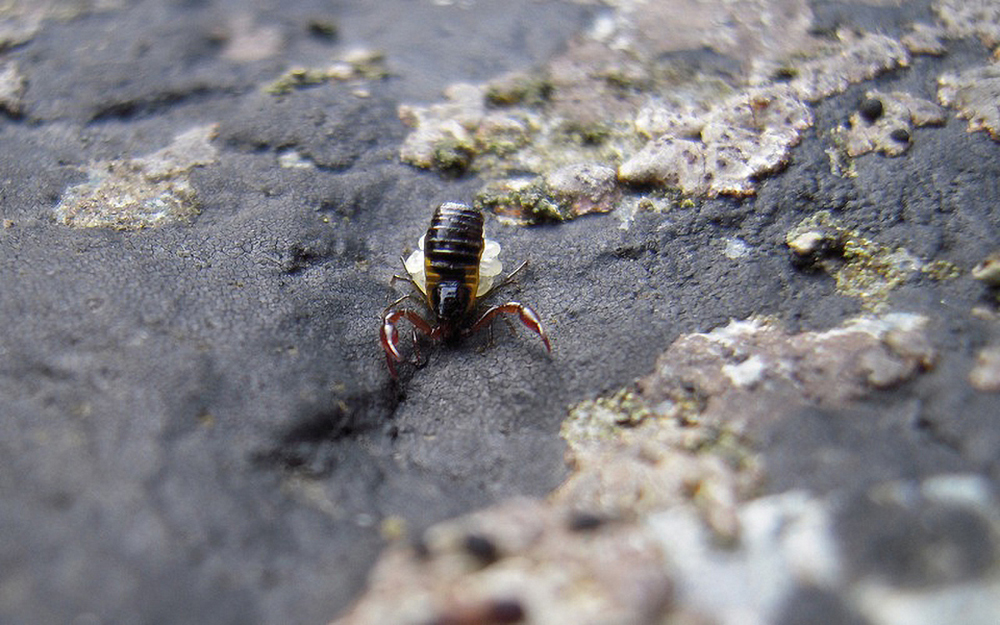
WHERE THEY ARE FOUND: Pseudoscorpions inhabit the soil, including in ant or ground nesting bee nests, and are also found in leaf litter and under logs, stones or bark.
WHAT THEY EAT: Pseudoscorpions hunt and immobilize springtails, mites, nematodes, potworms and larval soil arthropods using their venom.
LIFE CYCLE: Pseudoscorpions spin silken chambers in which they molt and overwinter. They can live up to three to four years. A female pseudoscorpion will carry a silken bag of 10 to 40 eggs, and her young will ride on her for a time after they hatch.
APPROX. NUMBER OF KNOWN SPECIES: 3,500 worldwide (420 in North America).
RELATIVE ABUNDANCE: Pseudoscorpions are not present in high density, with less than 300 per square meter.
NOTES OF INTEREST:
- Pseudoscorpions’ chelicerae are used for feeding and for producing silk. Sensory hairs on their pedipalps help detect prey.
- Some pseudoscorpions hitch rides on insects as a method of dispersal.
- These animals can be sampled using a Berlese funnel.
Scorpions
PHYLUM: Arthropoda » CLASS: Arachnida » ORDERS: Amblypygi, Schizomida, Scorpiones, Solifugae, Thelyphonida
SIZE: 0.31–6.69" (8 mm–17 cm).
ECOLOGICAL ROLE: Scorpions are predators, feeding on a variety of small animals. Most scorpions are also burrowers, digging several feet underground.
DESCRIPTION: All scorpions have segmented bodies, eight legs, a pair of chelicerae and a pair of pedipalps. True scorpions (Scorpiones) have a tail ending in a venomous stinger, often carried over their back, and pedipalps ending in pincers. Wind scorpions (Solifugae) have a rounded abdomen and no stinger, with large pedipalps used to seize prey. Wind scorpions, whip scorpions (Thelyphonida), tailless whip scorpions (Amblypygi) and short-tailed whip scorpions (Schizomida) run on their three hind legs and use the front pair of legs as feelers. Whip scorpions resemble true scorpions but have a long, thin tail. Tailless whip scorpions have very long legs, no tail and pedipalps modified for grabbing. Short-tailed whip scorpions have hind legs modified for jumping and a short tail extending from their abdomen.
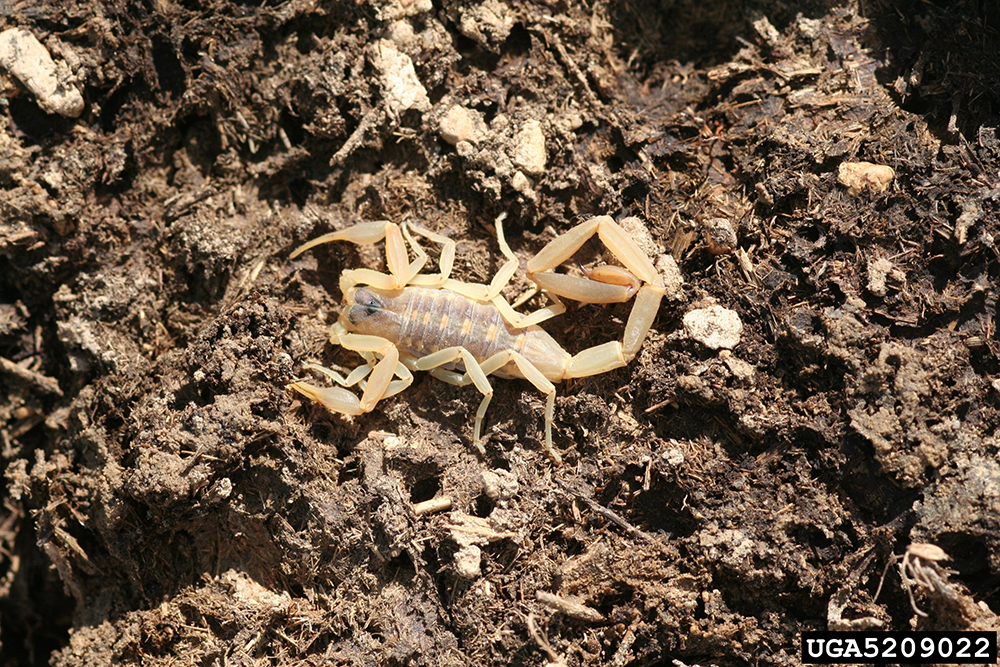
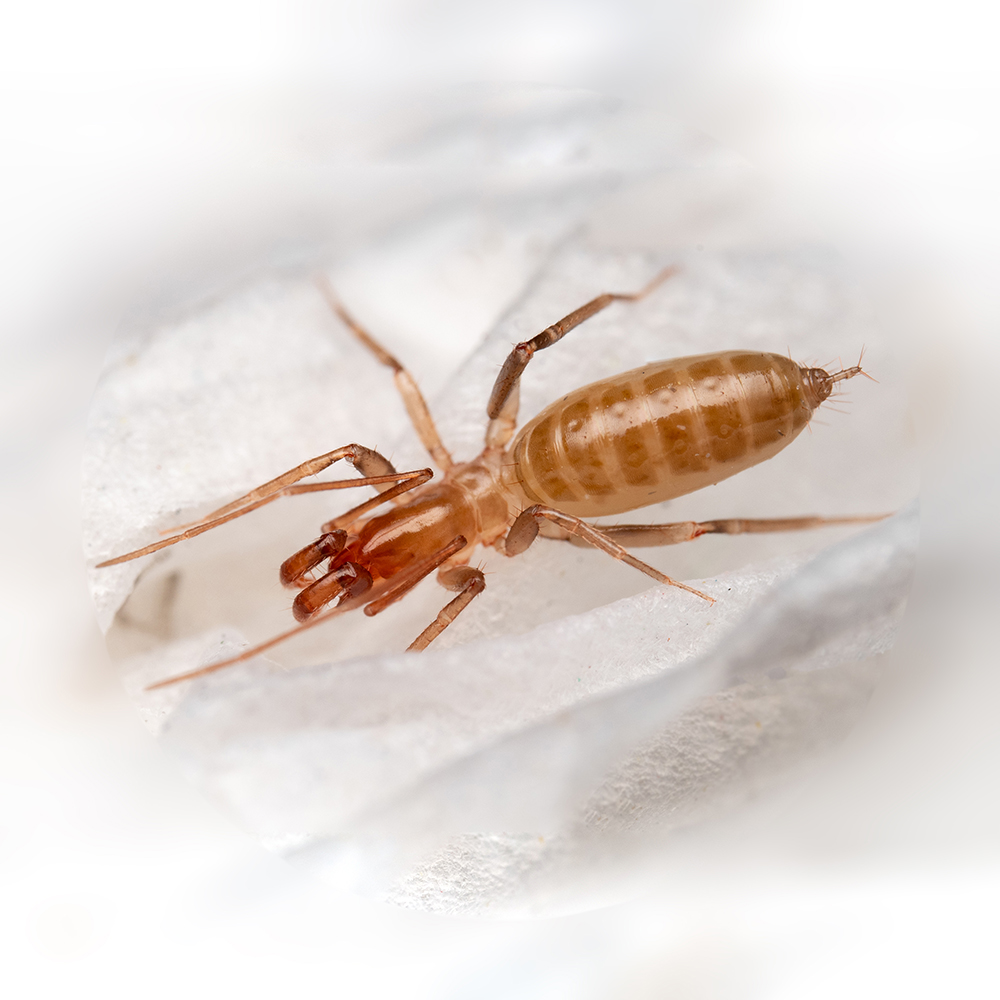
WHERE THEY ARE FOUND: Scorpions are found in hot, dry climates. Some true scorpions, as well as whip scorpions and short-tailed whip scorpions, also live in warm and humid climates. They can be found in soil, under logs or stones, or within burrows of larger animals.
WHAT THEY EAT: Scorpions are nocturnal hunters and emerge at night to feed on insects, centipedes, spiders and other arachnids, as well as small vertebrates like mice, lizards and snakes. Prey selection can be varied; up to 100 prey species were recorded for one scorpion species. Some scorpions can survive a whole year without food.
LIFE CYCLE: True scorpions birth live young and carry their young on their back for several weeks. Adult females of other scorpions also provide maternal care. Some species may dig deep burrows underground where they lay eggs. Others may carry eggs in sacs on their abdomens or stay in a chamber with their eggs until they hatch. Scorpions grow slowly and may take several years to reach maturity. They may live three to 10 years, or even up to 15 years.
APPROX. NUMBER OF KNOWN SPECIES: 1,950 true scorpions worldwide (70 in North America), 1,100 wind scorpions worldwide (200 in North America), 100 whip scorpions worldwide (three in North America), 150 tailless whip scorpions worldwide (nine in North America) and 230 short-tailed whip scorpions worldwide (60 in North America).
RELATIVE ABUNDANCE: Scorpions are not numerous.
NOTES OF INTEREST:
- True scorpions have a venomous sting but only about 1.5% of species pose a health risk to people. In the United States, the Arizona bark scorpion, Centruroides sculpturatus, is considered seriously dangerous to people; scorpion stings are avoidable by wearing shoes outdoors where scorpions are present and by shaking out shoes and clothes if they’ve been on the floor before wearing.
- There are 75 or so species of true scorpions in the United States, and the highest diversity is in the desert Southwest (e.g., there are 40 species in Arizona).
- True scorpions have both a type of venom to stun or warn predators or threats, and a type for killing prey.
- Wind scorpions (also called camel spiders) don’t have poison glands. Whip scorpions, which have no venom glands, spray acetic acid in defense.
- Scorpius is the only constellation of stars to bear the name of a soil organism, and it is one of two named for arthropods (the other is Cancer, the crab).
- The exoskeleton of scorpions will fluoresce under black light, so surveys can be conducted at nighttime.
This material is based upon work that is supported by the National Institute of Food and Agriculture, U.S. Department of Agriculture through the Sustainable Agriculture Research and Education (SARE) program. Any opinions, findings, conclusions, or recommendations expressed in this publication are those of the author(s) and should not be construed to represent any official USDA or U.S. Government determination or policy.
